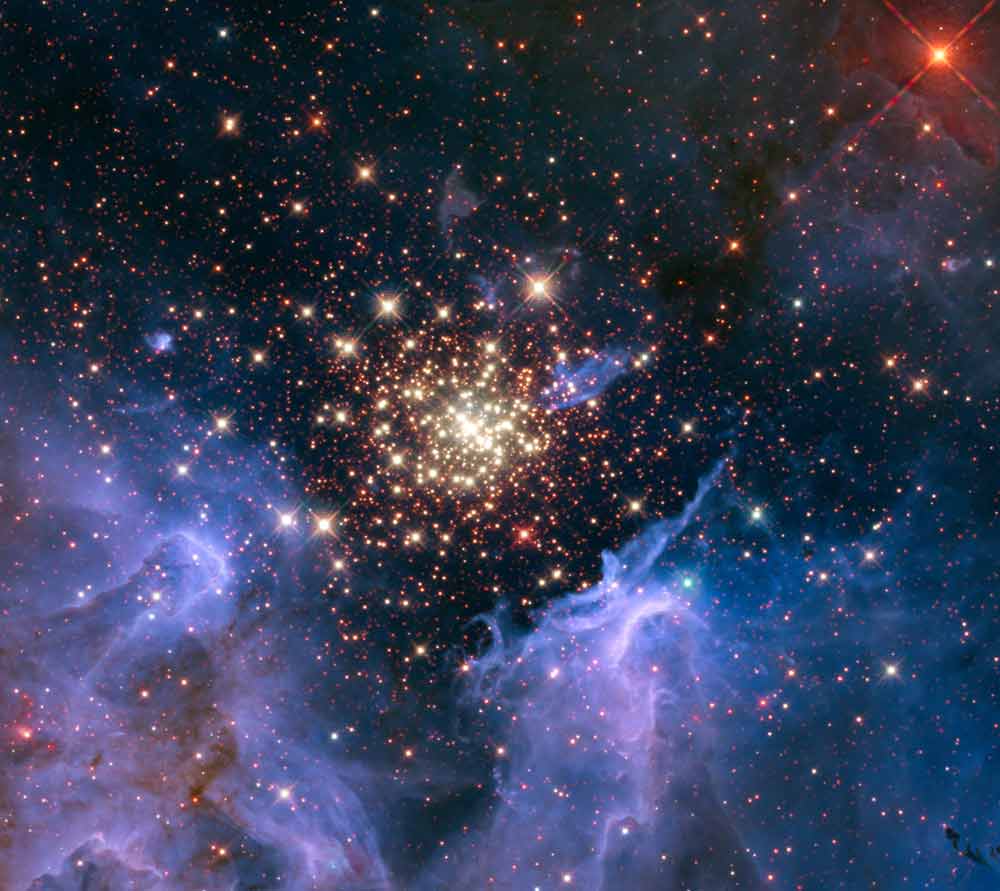Cosmic Clouds Part to Reveal Dazzling Space Fireworks

Ayoung, glittering collection of stars has been caught in the act of a dazzling celestialfireworks show, in a newly released photo taken by the Hubble Space Telescope.
The new Hubble space photo, which shows a nebula 20,000 light-years away in the constellation Carina, contains a central cluster of huge, hot stars called NGC 3603. Thisstar cluster is surrounded by clouds of interstellar gas and dust ? the rawmaterials needed to form new stars.
Whilethe stunning photo may look serene, the environment is actually quite volatile.Ultraviolet radiation and violent stellar winds have blown an enormous cavityin the bubble of gas and dust that envelopes the cluster. Coincidentally, thisgives Hubble an unobstructed view of the star cluster's heart.
TheHubble science team released the photo Tuesday, though it was actually takenduring several observations between August and December of last year.
Starclusters like NGC 3603 provide crucial information that helps astronomersunderstand the origin of massive star formation in the early, distant universe.
Mostof the stars in this cluster were born around the same time, but they differ insize, mass, temperature and color.
Sincethe course of a star's life is determined by its mass, star clusters of a givenage allow detailed analyses of stellar life cycles, as they contain stars invarious stages of their lives.
Get the Space.com Newsletter
Breaking space news, the latest updates on rocket launches, skywatching events and more!
NGC3603 also contains some of the most massive stars known. These stars live fastand die young, rapidly burning through their hydrogen fuel and ultimatelyending their lives in spectacular supernova explosions.
Astronomerscan also use massive star clusters to study distant starbursts that occur when galaxies collide. These cosmic impacts set off aflurry of star formation. The proximity of NGC 3603 makes it an interestingcase study for examining such distant and momentous events.
Theimage of NGC 3603 was captured by Hubble in August 2009 and December 2009 withthe telescope's Wide Field Camera 3 in both visible and infrared light.
TheHubbleSpace Telescope has been observing the universe for 20 years. It waslaunched in 1990 aboard a NASA space shuttle and been overhauled several timesby astronauts on later flights.
- Photos - 20 Years of the Hubble Space Telescope
- Spectacular Nebulas in Deep Space
- Top 10 Most Amazing Hubble Discoveries
Join our Space Forums to keep talking space on the latest missions, night sky and more! And if you have a news tip, correction or comment, let us know at: community@space.com.

Denise Chow is a former Space.com staff writer who then worked as assistant managing editor at Live Science before moving to NBC News as a science reporter, where she focuses on general science and climate change. She spent two years with Space.com, writing about rocket launches and covering NASA's final three space shuttle missions, before joining the Live Science team in 2013. A Canadian transplant, Denise has a bachelor's degree from the University of Toronto, and a master's degree in journalism from New York University. At NBC News, Denise covers general science and climate change.









